
views
Using Household Cleaners
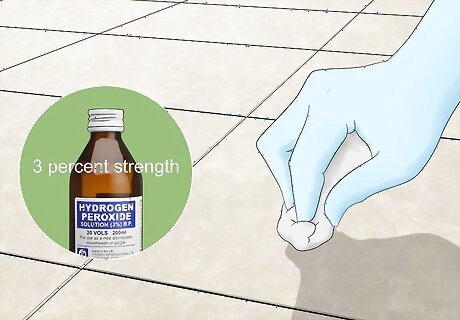
Dab the stain with 3 percent strength hydrogen peroxide. Hydrogen peroxide is a powerful cleaning chemical, even when diluted, so only use small dabs of the solution to clean away the stain. It is slightly corrosive, so wash the surface thoroughly with tap water as soon as the stain has disappeared. If your stain is particularly hard to remove, lay a rag soaked with hydrogen peroxide over the stain. Let it set for 1-2 hours. Then, remove the rag and proceed with scrubbing the stain. Before you use this technique to clean a stain in a visible area, try it out in an inconspicuous spot to make sure it won't damage your tiles. Hydrogen peroxide is particularly effective for cleaning coffee stains, nail polish, and blood stains on ceramic or finished tile. Hydrogen peroxide is a bleach-like chemical, so before you use any other cleaning sprays or solutions in the kitchen, wipe down the tiles thoroughly with water to remove any remnants.
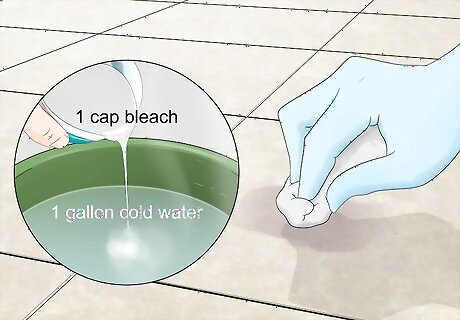
Dilute bleach in cold water for deep-set or organic stains. Pour a cap of bleach into a 1 gallon (3.8 L) bucket of cold water and mix it. Then, use a white cloth to dab and scrub away the stain. If the solution doesn't prove to be strong enough, add another cap full and try again, but be careful of how much you add as bleach is incredibly bad to get on anything except stains. Bleach is especially effective with ink, coffee, juice, and blood stains — basically anything that has a hard time being cleaned normally will be wiped away by bleach. Bleach is infamous for reacting with other cleaning solutions, especially ammonia-based solutions. Be absolutely certain that the bleach has been washed away, and let the area dry for a few hours before you use any other cleaning solutions near the tiles.
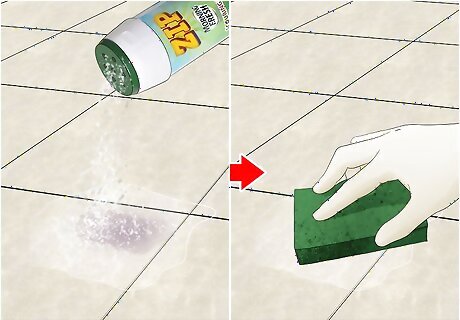
Scrub scouring powder into liquid floor stains to lift them. Wet the stain slightly with water, then sprinkle enough scouring powder onto the floor tile stain to completely cover it. Mix it gently with the water and let the paste sit for a few minutes to react. Then, wipe the stain with an abrasive sponge or a rag. Scouring powder is effective at cleaning common floor stains such as grease stains, food stains, and water marks. If you need to try another stain removal method, completely dry and clean the area with water first, as some chemicals in the powder could react badly with other cleaners.
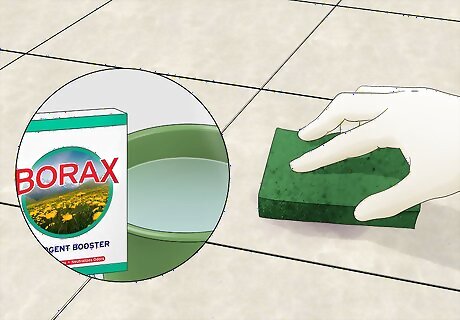
Mix borax and water to remove stains from floor tiles. Borax is a popular agent for cleaning clothes, but it is very effective at cleaning the kitchen too. Mix 1 cup (400 g) of Borax with ⁄4 cup (59 ml) and dip an abrasive sponge into the solution. Scrub the stained area of tile until it is lifted — this may require some elbow grease for particularly tough stains. Only use Borax on finished tiles, such as ceramic, porcelain, or marble. Mix 2 tbsp (50 g) of Borax with 1 gallon (3.8 L) of water to create a solution great for mopping the floor regularly, which can prevent stains in the first place.

Buy marble poultice for your marble tiles if other cleaning methods don't work. Simply rub the poultice paste onto the stain to a thickness of about ⁄4 inch (0.64 cm), cover the area with plastic and let it sit for 1 to 2 days. Wipe away the paste and check the stain to see if it was removed. Marble tiles have a different structure and makeup to other tiles, and although bleach and hydrogen peroxide generally work, marble poultice is specially made to clean this material. Re-apply the poultice as necessary if the stain wasn't absorbed, and leave it for more than 1 day if the stain is particularly deep-set. EXPERT TIP Melissa Maker Melissa Maker Founder, Clean My Space Melissa Maker is host and editor of CleanMySpace, a YouTube channel and blog with over 1 million subscribers. She has over 10 years of professional cleaning experience, and dispenses helpful tips on all things home. Melissa Maker Melissa Maker Founder, Clean My Space For tile stains, start by identifying the offending substance to select the best removal method. Oil-based stains like grease may lift after rubbing with baking soda paste while ink responds better to alcohol or acetone. For the toughest stains, a steam cleaner delivers heat and pressure to lift discoloration without harsh chemicals.
Trying Natural Solutions
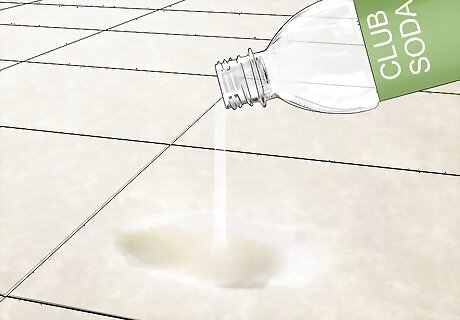
Pour club soda on the stain and let it sit to lift sugary or fatty stains. Choose a flavorless, sugar-free club soda — water and carbonation are enough to get the job done. Pour enough soda onto the stain to create a pool of water, and let it sit and react for a few minutes. The carbonation should lift the stain effectively, so simply wipe away any remaining liquid and scrub the stain with an abrasive sponge. Club soda is most effective for cleaning grease stains and fat-based stains, but you may find it effective in cleaning sugary stains and messes as well, such as from spilled soda.

Use white vinegar to clean stains out of the grout between tiles. Pour some white vinegar on an abrasive sponge and wipe the grout lines roughly to lift dirty or black residue. Don't mix the vinegar with baking soda or any other cleaners or it could cancel out the cleaning properties of both ingredients. If the area is still dirty, wipe the vinegar away with water before trying another cleaning method. White vinegar is great for grout, but is also effective for cleaning household ceramics such as bathtubs, toilets, and sinks. It's especially useful for removing hard water stains. Be sure to use full-strength vinegar to maximize its cleaning effectiveness. Look for full-strength vinegar in the cleaning section, as cooking vinegar isn't as strong.
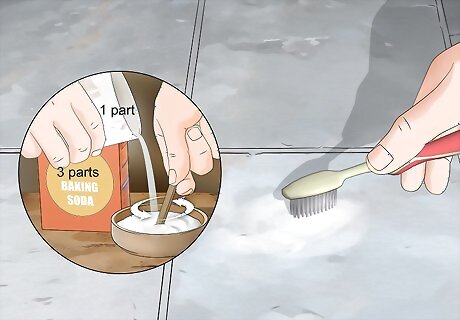
Opt for a mix of baking soda and water to clean non-ceramic tiles. Ceramic, marble, and other tiles with a finish coating are easily cleaned using the other methods in this guide, but slate and otherwise unglazed tiles must be cleaned with a mix of baking soda and water. Mix 3 parts baking soda with 1 part water in a bowl, stir it into a paste, then scrub the paste onto the stain with a toothbrush. Baking soda and water is preferable for slate as it won't leave any permanent marks that could be easily washed away on ceramic or other glazed tiles. Baking soda is good to use for small, sticky stains, but with some elbow grease can also be effective for larger stains. After you clean with baking soda, it's normal to have a white glaze left on the surface you cleaned. To prevent this, rinse the area well and wipe it down 2-3 times with a clean rag.

Spray lemon juice on hard water stains on finished tiles. Lemon juice is very acidic and will lift hard water stains easily from finished tiles. Simply spray the lemon juice onto the stain, or soak a rag or sponge in the juice, and scrub the area until the stain is lifted. Only use lemon juice on finished tiles, like ceramic and porcelain, and never on stone or slate tiles, as the acidity could cause unremovable stains in the material.
Using Ice to Remove Sticky Stains
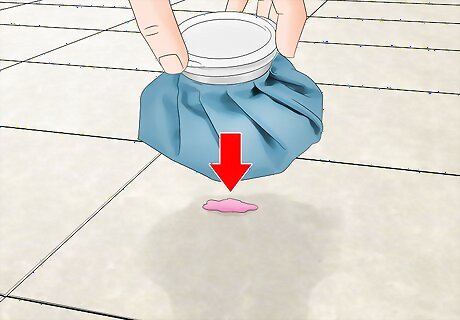
Fill a plastic bag with ice cubes and lay it over the wax, gum, or tar stain. Fill a sealable plastic bag with ice to the size of the stain — most small stains only need a sandwich bag, but larger stains may require the use of a freezer bag to cover the whole area. Freeze some ice cubes in advance so you can easily fill the bag and start removing the stain from your tile. This method only works on gummy stains, including tar, wax, and glue, as it hardens the material and makes it easier to chip away. Don't try to freeze a liquid stain or you will be disappointed with its ineffectiveness. Liquid nitrogen has been shown to be effective in removing gummy stains, but it can be hard to control precisely and can cause damage to your tiles — avoid it.
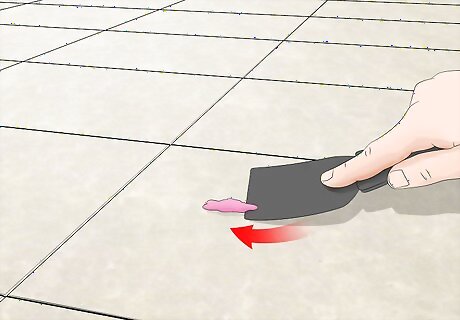
Scrape away the stain with a wooden stick once it solidifies. Take away the ice bag after about 1/2 hour to 1 hour, and check to see if the stain has solidified. If it has, take a wooden stick, such as a popsicle stick, and chip it away. Don't worry if you can't get it all removed in one clean go, just chip away the solid parts rising above the tile as best as you can. Do not use a metal or ceramic stick as this will scratch your tile, creating another aesthetic problem — it's the same reason why it's best use a wooden spoon in a metal pot.

Remove any remaining residue with paint thinner. Use a dab of paint thinner on a rag to remove any last remnants of the stain from the tile. You may find it effective to clean the spot with an abrasive sponge, but be sure to buy a sponge that is rated for your tile's material, and avoid using steel wool. You can find paint thinner at any hobby store or hardware store. If the stain is persistent, apply the ice bag for another hour and try again, as the gum, wax, or tar may have warmed up and become sticky again.




















Comments
0 comment